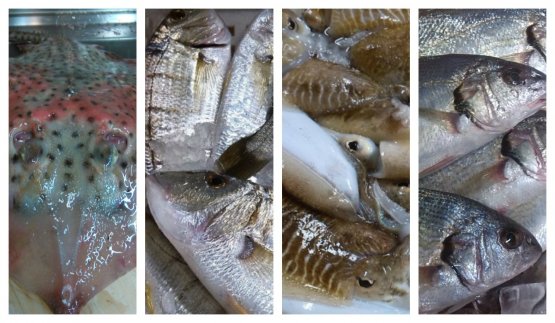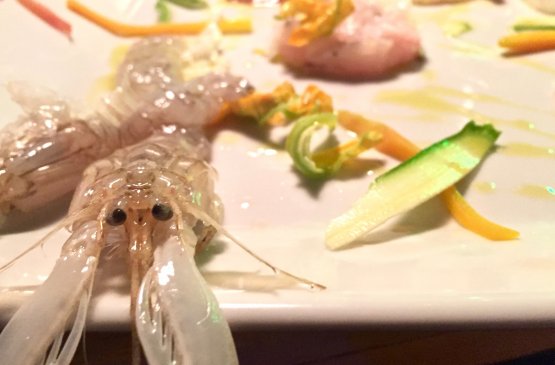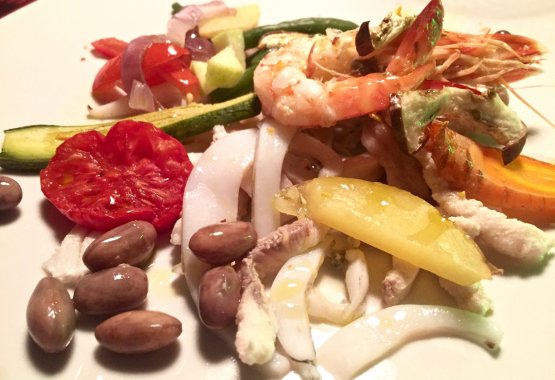“90% of the people who go to restaurants expect fresh and healthy products. The problem is they order products that are not in season, nor local. As a consequence, they want to be made fun of”.
Among the many futile profiles on Facebook, Amelio Fantoni’s is instead full of thoughts like this. He’s a chef with a long experience in Viareggio, twenty years at the famous Rugantino, and since 2005 in his simpler and straightforward Buonumore. His thoughts are worth considering and deserve some extra attention.
Also from Facebook: “What does “poor fish” mean? Is it because it costs little? Is it because it has no market? Why is it that great chefs don’t use it (or don’t know how to use it)? What I’d like to know: why don’t people from Versilia make our fish known? Besides, it could also be considered a touristic specialty of our area… Let’s free Versilia from indecent proposals such as calamarata, carbonara, paranza, grilled fish and other junk. You need a great knowledge of raw materials and of cooking techniques”.
“Junk” aside, these are beautiful thoughts. So let’s speak to the furious Fantoni in person: «I’m not furious. There’s no such thing as “poor fish”, I don’t know what this means. Why poor? Not in terms of taste, not because of lower quality. It’s just that markets set the price, and demand is low. It’s low because of ignorance».

The real catch in Versilia: ray, mormore, squid, umbrine (photo Simona Fantoni)
Facebook: “
The question is: why do great chefs use few fish species (we have around 800 varieties in our sea and the few used are scarce, at least here)?”.
Is it ignorance?
Fantoni gives context: «Until the Sixties, that is until fishing boats had engines, 98% of fish species – that is to say those that live below 50 metres deep – could not be caught. Think of Liguria, where the sea bed immediately reaches 200 metres. That’s why their cuisine is based on meat. People only knew few species – the remaining 2% - the most famous even these days, and still order those». It’s a closed circuit: the average guest knows sea bass and prawns, and order sea bass and prawns. Hence restaurant patrons need to buy these without offering guests something different, because there’s no demand. Other fish is still unknown. A work of awareness is what we need.
Again on Facebook: “The fish caught in this season by fishermen in Viareggio is squilla mantis, ray, horse mackerel, small octopus, sea mullet, a few squid, aluzzi, anchovies, some turbot, bluefish, small mullet, fish for frying, small soles, a little scampi, some sea bass. Mostly fish people don’t know. The question is: why do people want fresh fish that is not local? Perhaps the same fish you eat in big cities seems better by the sea, even though it’s not caught here? Think of the classic seafood: it is very popular but it has never been here!”.
Fantoni says to us: «Here in Versilia we have some 200 varieties of fish. There’s very little crustaceans, mostly sparnocchie (the local name for tiger prawns) and squilla mantis. As for seafood, only arselle. There’s nothing else, it comes from elsewhere. It arrives to Viareggio in the same way it arrives in Milan. So when people from Milan who come to Viareggio order the “usual fish” in Versilia, they eat the same things they’d eat in their hometown. They come to the sea and ask for fish farmed in the countryside, full of antibiotics. It makes no sense». Besides, the flavour of fish depends on temperature, deepness, diet. This is where the nuances come from. While farmed fish is inevitably bland, standardised, always the same.

Raw fish starter at Buonumore, with squilla mantis, umbrine and ray
Facebook: “
In Versilia there are today 600 seafood restaurants. The miracle is they all offer crustaceans, sea bass, turbot, lobster, crayfish, king prawns and so on. Let’s say each restaurant buys 5 kilos of the above-mentioned fish every day (in fact, they buy much more). Where do they get them? Who caught them?”.
Tell us more,
Amelio: «Let’s say that the restaurants are 500, to be keep low. Every day each one sells kilos and kilos of catch that you can’t find in Versilia, or it’s rare to find. There’s no sea bass or they’re small and very few. Scampi? There are five boats that catch them in the sea bed between Elba and Capraia. They come back with 300-400 kilos, on a good day. This is surely not enough. Turbot? I counted seven. No soles, unless small. No monkfish, snapper, amberjack, tub gurnard».
Facebook: “Why do all the great chefs use amberjack for their fish? And scampi, lobster and king prawns as crustaceans?”.
Fantoni to Identità Golose: «Over here we have sea mullet, bluefish, mormore, umbrine, horse mackerel, ray... You certainly need skills to use them, and clean them. And you must go beyond aesthetics. Some are really ugly, because they come from the sea bed. They live in the dark, like mostelle. Think of sole and turbot: they cost 30-40 euros per kilo and have 70% waste. Ray costs 5-10 euros per kilo and half of its 70% waste can be reused, as it belongs to the shark family so it mostly feeds on live fish. It’s much healthier and rich in terms of nutrients. It’s delicious. But you need to know how to cook it, because it has strong muscles which can easily become hard, if you don’t handle the heat well while cooking».

Seafood salad at Buonumore: verdesca, horse mackerel, ray, sparnocchia...
jokes when he speaks about his
Buonumore : «It’s a dump». It’s a lie: it’s a simple place, but for experts. Helped by his daughter
Simona, born in 1973 (he’s from 1948), he uses the following trick so that guests can’t order fish that’s not from Versilia: set menu and set price. They explain the dish when they serve it, «guests must trust me, and I do a little education». You get what you get, but you’re not disappointed.
We recently got toasts with moray eel cheek, pancotto soaked in a broth of left over vegetables (60%) and heads of moscardoni [large moscardini octopus] and squid (40%) - «moscardini grow, you can eat them one month a year, then they become moscardoni» - raw squilla mantis, umbrine and ray with panelle and apple sauce («I don’t do anything, I just buy them»), then sea mullet marinated in water and sugar, apple, soy mayonnaise and oranges, then a delicate seafood salad with verdesca, horse mackerel, ray and sparnocchia, and finally spaghetti with grongo sauce («You cook the pasta then season everything with oil aromatised with citrus fruits, tomato and herbs»). No sautéed ingredients, very little salt and seasoning. Pure taste, no manipulation. And most of all: delicious.
As Fantoni says again on Facebook: “Perhaps it’s age. But I don’t understand: people expect fresh and seasonal fish from me. They then want me to improve it with my creativity... I’m very sorry but I’m not capable of improving nature. I can only respect it”.